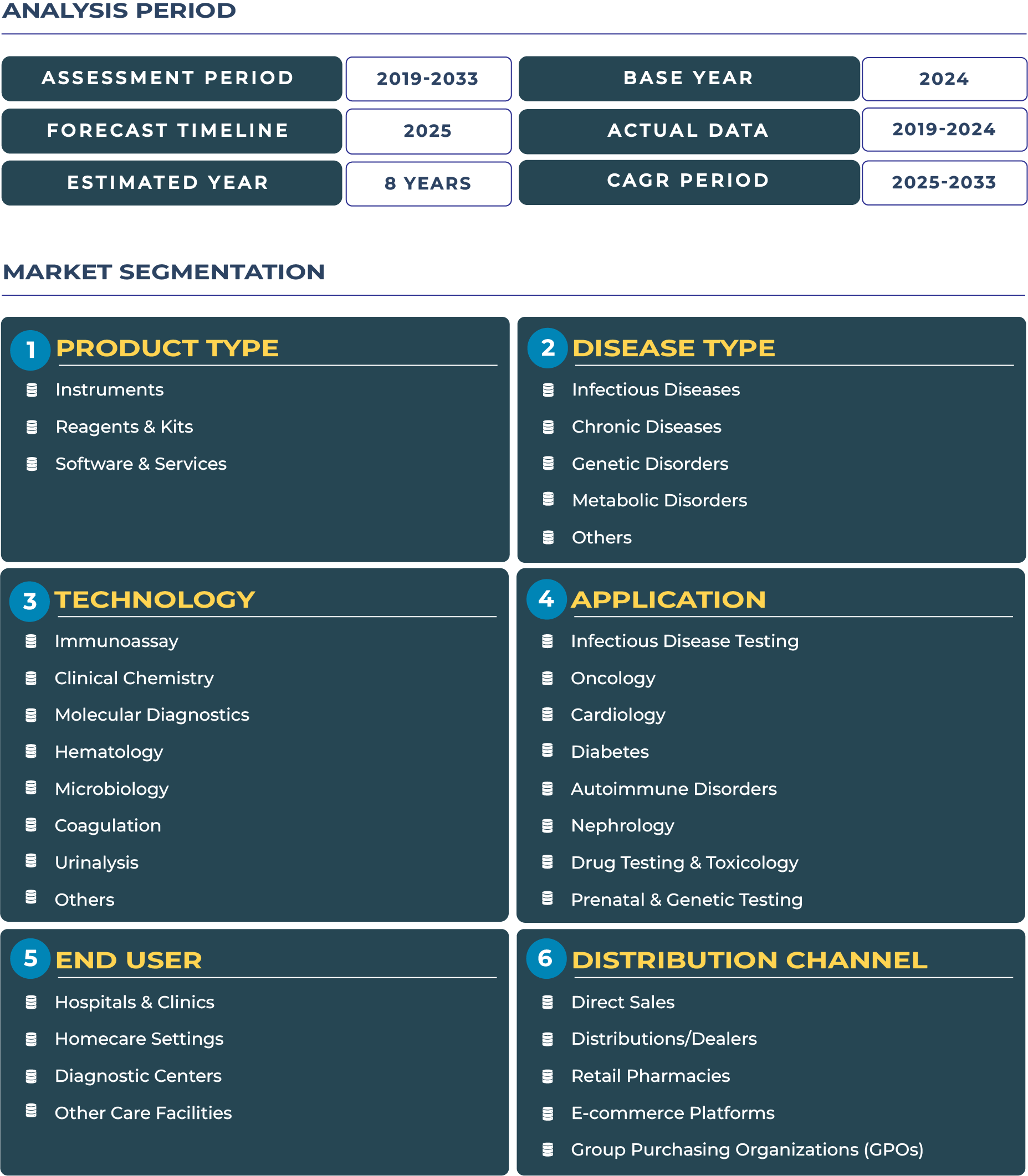South Africa In-Vitro Diagnostic Market Outlook: Navigating Dual Healthcare Dynamics in a Transitioning Economy
Start with South Africa’s healthcare duality driving orthopedic and diagnostic demand: In South Africa, a pronounced divide between the private and public healthcare sectors exerts major influence on adoption of advanced medical technologies. The private sector, serving a minority of the population, often demands cutting-edge diagnostics and precision solutions, while the public system services the majority with cost-sensitive procurement needs. This duality creates both opportunity and tension within the In-Vitro Diagnostic (IVD) market. Based on projections, the South Africa IVD market is expected to grow from about USD 653.3 million in 2025 to USD 836.8 million by 2033. This growth is driven by expansion in public diagnostic capacity, stronger private hospital investments, and the country’s evolving healthcare policy landscape under the newly signed National Health Insurance (NHI) framework.
Diagnostic modernization is becoming central to bridging gaps in trauma, orthopedics, and chronic disease management, especially in underserved provinces. National health policies increasingly prioritize laboratory infrastructure upgrades, digital health integration, and scalable testing platforms that can serve both high-end private clinical workflows and broader public system needs. The role of reagents, consumables, and software services is intensifying, as economies of scale and operational efficiency become competitive differentiators across both healthcare tiers.
Drivers & Restraints: Clinical Base Strength Meets Systemic Constraints
Strong Clinical Foundations and Private Hospital Base Fuel Diagnostic Demand
South Africa possesses one of sub-Saharan Africa’s most mature medical ecosystems, including a well-developed private hospital network (e.g. Netcare, Mediclinic) and a cadre of skilled specialists who demand high-quality diagnostic support. The private sector’s demand for advanced imaging, molecular diagnostics, and immunoassays cascades into vendor investment and market pull. Meanwhile, the public sector, funded through provincial and national budgets, is investing in large-scale labs, expansion of HIV/TB infrastructure, and diagnostic decentralization. Public procurement still commands the majority of diagnostic volume in the country. The public sector’s procurement flows, although fragmented provincially, offer significant scale potential for diagnostic vendors.
Macroeconomic Volatility, Inequitable Access & Public Underfunding Impede Growth
Notwithstanding strong clinical foundations, South Africa IVD market is constrained by macroeconomic uncertainty, currency volatility, and budget pressures on the public sector. Public healthcare remains underfunded relative to demand, and disparities in access between urban and rural provinces persist. The private system’s high cost of care excludes large segments of the population, limiting the addressable diagnostic market. Additionally, provincial procurement decentralization adds administrative complexity for vendors, elongating sales cycles and increasing compliance burden. The risk of supply chain disruption and reliance on imports of reagents and kits further compress margins in lower-margin public tenders.
Trends & Opportunities: Consolidation, Digital Labs & Public-Private Pilots
Private Clinic Consolidation, Medical Tourism & Donor Programs Redirect Growth Paths
One abiding trend is consolidation among private diagnostic and medical clinic chains, creating networks that demand standardized diagnostic platforms, reagent supply consistency, and interoperable software. South Africa also benefits from medical tourism in specialized areas such as orthopedic surgery and oncology, which brings inbound diagnostic referrals. Meanwhile, donor and international health programs, especially for HIV, TB, and malaria, continue to subsidize and stimulate diagnostic demand in the public sector. These external funding flows create tactical openings for diagnostic firms to introduce novel platforms in resource-challenged settings.
Opportunities in Tiered Product Lines and Public-Private Performance Pilots
To capture both private and public sector demand, diagnostic vendors can adopt tiered product families, premium, mid-tier, and essential lines, with differentiated reagent settings and automation levels. In parallel, performance-driven pilot programs with provincial health departments allow vendors to showcase cost-efficiency, diagnostic turnaround times, and outcome improvements. These pilots can serve as proof points for scaled adoption. Partnerships with non-profit entities, universities, and provincial health agencies also open routes for co-development of localized assays or regional supply chains, improving resilience and local relevance.
Competitive Landscape: Private Systems, Public Partnerships & Tier-ed Strategies
Leading multinational diagnostic firms, such as Roche Diagnostics, Abbott, Siemens Healthineers, Thermo Fisher, and bioMérieux, maintain strong presence in South Africa, often via local distributors or servicing arms. In the private hospital domain, vendors compete on service, reagent reliability, and data integration. On the public side, diagnostic suppliers must navigate provincial tenders and capacity building agreements. Some firms are launching laboratory automation hubs and training academies to gain differentiation. Strategic alignment with private hospital chains for exclusive instrument placements, or offering reagent-rental contracts to public labs, continues to be central to competitive strategy. The emergence of digital diagnostics and remote monitoring opens new competitive frontiers for software-as-a-service overlay models that complement device sales.







